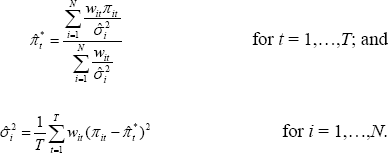RDP 2005-05: Underlying Inflation: Concepts, Measurement and Performance Appendix: Derivation of Underlying Inflation Estimators
July 2005
- Download the Paper 192KB
First, we show how to derive the double-weighted measure described by Laflèche (1997) as a maximum likelihood estimator of underlying inflation, along similar lines to Diewert's (1995) derivation of the neo-Edgeworthian measure. The model is defined by the equation:
Assume that E(νit)=0 and  , for i =
1,…, N and t = 1,…,T. Assuming further
that we are sampling from a normal distribution, the log-likelihood function
for this model, aside from a constant, is:
, for i =
1,…, N and t = 1,…,T. Assuming further
that we are sampling from a normal distribution, the log-likelihood function
for this model, aside from a constant, is:
Partially differentiating with respect to  and
and  ,
and setting the resulting expressions equal to zero, yields the following
system of T + N simultaneous equations that can be used
to determine the maximum likelihood estimators for the model:
,
and setting the resulting expressions equal to zero, yields the following
system of T + N simultaneous equations that can be used
to determine the maximum likelihood estimators for the model:
Note that the formula for  multiplies relative price inflation at each point in time by the effective expenditure
weight, and thus does not correspond to the usual notion of a variance.
multiplies relative price inflation at each point in time by the effective expenditure
weight, and thus does not correspond to the usual notion of a variance.
Similar measures have been proposed before (for example, Laflèche 1997, Marques et al 2000, Aucremanne 2000), but by using the reciprocal of the sample standard deviation they only approximate this estimator. The neo-Edgeworthian measure is usually constructed in a similar ad hoc manner, although it has been more rigorously estimated as the solution to a full system of equations for the US and for the euro area by, respectively, Wynne (1997) and Vega and Wynne (2003). Regular breaks in the Australian CPI would make precise estimation of either the double-weighted or neo-Edgworthian measure difficult in the Australian context.
Second, we derive the weighted mean of the distribution of price changes, in the
spirit of Clements and
Izan (1987). One could also do this for the trimmed distribution of
price changes, assuming that the trimmed price changes are simply outliers
that have been ‘cleaned’ from the data. In the Australian case,
this could make the assumption that we are sampling from a normal distribution
more defensible. The model is comprised of
Equation (A1) and the assumptions that E(vit)
= 0 and  .
The only difference compared with the previous model is that now
.
The only difference compared with the previous model is that now  is assumed to be
common to all goods and services. This time, the log likelihood function
is:
is assumed to be
common to all goods and services. This time, the log likelihood function
is:
Differentiating with respect to  and setting the partial derivative equal to zero, we have:
and setting the partial derivative equal to zero, we have:
Since  cancels out, the maximum likelihood estimator for the systematic component of inflation
is:
cancels out, the maximum likelihood estimator for the systematic component of inflation
is:





